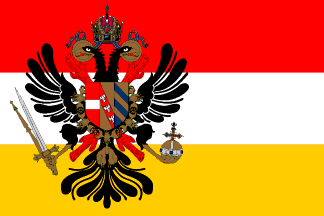

Last modified: 2021-02-13 by ivan sache
Keywords: austrian netherlands |
Links: FOTW homepage |
search |
disclaimer and copyright |
write us |
mirrors
Flag of the Austrian Netherlands, 1781-1786 - Image by Mario Fabretto, 9 November 1999
See also:
Originally all "17" Dutch provinces (Burgundian kreits)
revolted against the Spanish King Philip II, but in 1579 the southern
provinces decided to stay loyal, and they remained Spanish. They
became known as the Southern or Spanish Netherlands, while the Northern Netherlands formed
the Republic of the United
Netherlands.The southern provinces were "convinced" to stay loyal by the
Spanish army, accordingly the entire intellectual elite from the
Southern Netherlands moved to the Northern Netherlands.
In 1713, at the end of the Spanish Succession War, the Spanish Netherlands became the Austrian Netherlands (Oostenrijkse Nederlanden, Pays Bas autrichiens) and remained so until the conquest by France in 1795. The country was divided in two by a broad stripe
consisting of Sticht Luik (Bishopric of Liège) and the
abbey of Stavelot. Eight cities in the Austrian Netherlands were declared "barrier cities" with a Dutch garrison
until 1781; there were eight redemptie-dorpen (redemption
villages) northwest of Liège, which belonged to
Staats-Brabant (the Dutch part of Brabant, now
Noord-Brabant). The whole territory was
littered with enclaves, uncertain boundaries, etc.
In 1814 the Southern and Northern Netherlands were reunited, together with the former Principality-Bishopric
of Liège which had been neutral until then, to form the Kingdom of the Netherlands. However, the
differences turned out to be too big and the South revolted to form
Belgium in 1830.
Mark Sensen, Filip Van Laenen & Jarig Bakker, 9 November 1999
The flag used as the civil ensign of the Austrian Netherlands from 24 September 1781 to 31 December 1786 is in proportion 2:3, horizontally divided red-white-yellow. Behind the Imperial Austrian eagle is the Cross of Burgundy. On the shield, the fields represent, from left to right, Austria, Lorraine and Burgundy.
[The Flag Bulletin
[tfb] #32, 6/155 (1993)]
Mario Fabretto & Mark Sensen, 9 November 1999
Flag of the Oostendse Compagnie
The Oostendse Compagnie was founded by Emperor Charles VI
in the Southern Netherlands to promote ecomomic life; by Octroy of 19
December 1722, the Compagnie impériale et royale des Indes
Orientales, établie dans les Pays-Bas autrichiens got the
monopoly for 30 years of trade with East- and West-Indies and Africa.
The company was allowed to make treaties with indigeneous peoples and
to found colonies.
The ships sailed from Ostend (the only port in the Southern
Netherlands after the closure of the river Scheldt) to China (Canton)
and India (Gabelon and Banquibazar). The company grew rapidly and
both England and the Northern Netherlands got upset. The United
Provinces doubted the legitimacy of the Flemish colonial trade, based
on Hugo de Groot's De iure belli ac pacis, while the Southern
Netherlands based their policy on Hugo de Groot's Mare
liberum. However Charles VI needed the approval of the Northern
Netherlands and England (sic!) for the recognition of his daughter
Maria-Theresa as his successor (Pragmatic Sanction), so he suspended
the Compagnie on 31 May 1727 (Preliminaries of Paris) and revoked the
Octroy on 16 March 1731 (Treaty of Vienna).
[Nijhoffs Geschiedenislexicon Nederland en
België (1981)]
Jarig Bakker, 3 August 2001
The flag of the Oostendse Compagnie is shown on a print of a ship, entitled "Schip der Oostendse Compagnie" (photo).
Hans Vermeersch & Ivan Sache, 13 February 2020